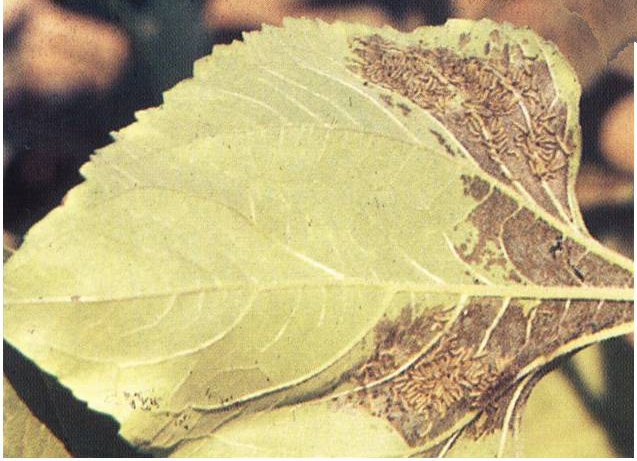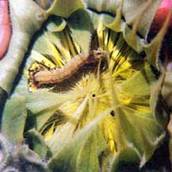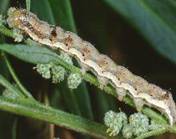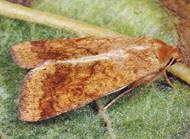Crop Protection :: Oil Seeds :: Pest of Sun flower
Capitulum borer (Head borer): Helicoverpa armigera
|
Symptoms of damage:
- The larva feeds on the developing seeds and bore the head
- Fungal developed and head starts rotting
- The larva consumes leaf in early stage of growth and move towards the capitulum and tunnel the head
|
 |
 |
|
|
| Leaf feeding |
Larva feeding in seed |
Caterpillar bore into head |
|
|
Identification of the pest:
- Egg: Spherical in shape and creamy white in colour, laid singly
- Larva: Shows colour variation from greenish to brown. It has dark brown grey lines on the body with lateral white lines and also has dark and pale bands
- Pupa: Brown in colour, occurs in soil, leaf, pod and crop debris
- Adult: Light pale brownish yellow stout moth. Forewings are olive green to pale brown with a dark brown circular spot in the centre. Hind wings are pale smoky white with a broad blackish outer margin
|
|
Management:
- Grow inter crops like, green gram, black gram, groundnut, soybean
- Sow 3-4 lines of maize (or) jowar around the sunflower crop to monitor the moth
- Sow trap crops like marigold at 50 plants/acre
- Use of pheromone traps (4 traps/acre) for pest intensity identification as well as to trap the male moths
- Setting of light traps (1 light trap/5 acre) to know the range of pest incidence as well as to kill moth population
- Release predators like coccinellids, Chrysoperla carnea @1larva/ head
- Release parasitoides like Trichogramma spp.@ 20,000/acre, (Bracon spp., Campoletis spp)
- Spray HaNPV 250 LE + Bt @0.5kg/ha for effective control
- Spray HaNPV 250 LE/ha +1 kg Jaggery + 200ml Sandovit (or) Teepal; mixing and spray in the evening hours only
- Spraying of 5% Neem oil or 5% Neem Seed Kernal extract before egg laying
|
|
|






